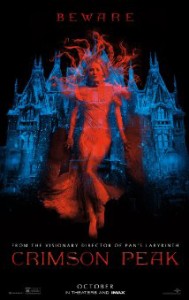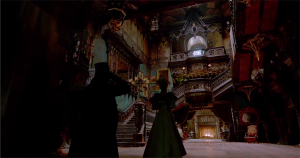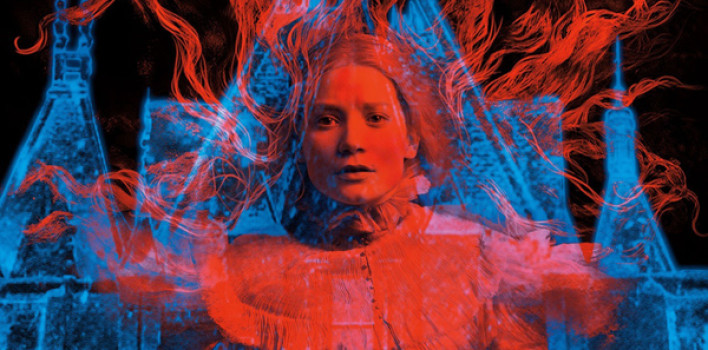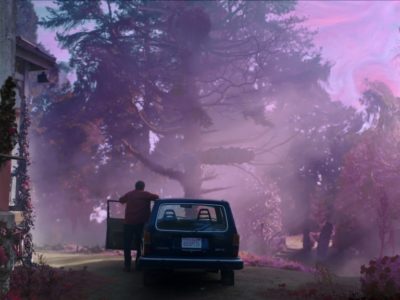Review| Crimson Peak
 Edith Cushing: “Ghosts are real, that much I know. I’ve seen them all my life…”
Edith Cushing: “Ghosts are real, that much I know. I’ve seen them all my life…”
Horror movies aren’t particularly my thing, you know? I’ve seen the big hitters: The Exorcist, The Shining, (Fill in the one I’m missing here), but I rarely go to the theaters to catch the latest Paranormal Activity orSaw film. On some rare occasions, my love for a director crosses with my disinterest in the horror genre and my hand is forced.
When I first heard of Guillermo Del Toro, I was wrapping up my primary days at Mill Creek Middle School, and he was putting out his first installment into the Hellboy franchise. I caught up with him again in 2008, as he was adding in his second installment, and then again when Pacific Rim combined all of my childhood dreams into one super film: monsters versus giant robots. It was right before Pacific Rim that I heard about his big claim-to-movie-fame in Pan’s Labyrinth. The year it came out it won 3 Oscars, was nominated for 3 more, and Del Toro was immediately made into an icon in the movie industry.
 His next horror film, after Pan’s Labyrinth in 2006, came to a wide release this past Thursday night. Crimson Peak is a period piece, set in late 19th century England and America. The story centers on a young girl, Edith Cushing, who tragically lost her mother as a child, and experienced visitations from her mother’s ghost periodically. As she grew, she found she was seeing more and more of the ghostly realm than one would expect. Her father, a rich architect very keen on keeping her safe, intended to set her up with the local doctor, but when a low ranking baron from England comes to town seeking capital for a mining operation, Edith is swept off her feet. Pulled into a family with more questions than answers, and more tension than love, she moves to the baron’s ancestral home to live there with him and his sister.
His next horror film, after Pan’s Labyrinth in 2006, came to a wide release this past Thursday night. Crimson Peak is a period piece, set in late 19th century England and America. The story centers on a young girl, Edith Cushing, who tragically lost her mother as a child, and experienced visitations from her mother’s ghost periodically. As she grew, she found she was seeing more and more of the ghostly realm than one would expect. Her father, a rich architect very keen on keeping her safe, intended to set her up with the local doctor, but when a low ranking baron from England comes to town seeking capital for a mining operation, Edith is swept off her feet. Pulled into a family with more questions than answers, and more tension than love, she moves to the baron’s ancestral home to live there with him and his sister.
The movie goes on from there, putting into place all the expected and unexpected tensions required for a horror movie centered around a love story occurring in a creepy old mansion, and then goes on a bit further to surprise you again and again with what I can only describe as a lack-of-a-twist. That term seems to imply my having a negative view on this film, but rest assured my view stands starkly on the other side. In Crimson Peak, Del Toro offers countless nods to tropes within the horror genre, and while reminding us of scenes from all the movies we have seen in the past, he uses these tropes to tell a story that is quite different from most of them.
 I expected so many things in the movie to turn out to be ‘not quite what they seemed’, but Del Toro used all of my assumptions against me, in a way that was quite refreshing. If every movie with a dark and scary trailer held all of this back for the full film, I would watch even more movies than I already do. I’d love to give away all of the incredible themes and ideas, but being that it is the Monday after release, and most of you haven’t seen it, I won’t.
I expected so many things in the movie to turn out to be ‘not quite what they seemed’, but Del Toro used all of my assumptions against me, in a way that was quite refreshing. If every movie with a dark and scary trailer held all of this back for the full film, I would watch even more movies than I already do. I’d love to give away all of the incredible themes and ideas, but being that it is the Monday after release, and most of you haven’t seen it, I won’t.
I will point out my love for the way death is portrayed in this film, especially in the home from which this movie gets its name. The mansion is filled with memories and stories, that leave behind a trail that is so nuanced and exciting that there was more than one point where I was looking for the next bread crumb, rather than paying attention to the plot.
Del Toro, as he does in all of his films, designs a set that is so incredible and breathtaking, that I would watch this movie without sound. If the color had just a bit of sepia, I would’ve thought I was watching something from Orson Welles or Michael Curtiz. The script was heavy handed, to its’ benefit, adding to movie’s 1940s feel. As he did in Pan’s Labyrinth, he again draws you into a story that seems just off the edge of our own reality, and encourages you to believe that maybe his stories just might be true.








Pingback: #077 – Crimson Peak and Understanding Our Monsters | Reel World Theology